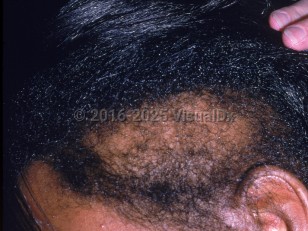Congenital triangular alopecia - Hair and Scalp
Alerts and Notices
Important News & Links
Synopsis

Congenital triangular alopecia (CTA), also known as Brauer nevus, hypotrichotic nevus, and temporal triangular alopecia, is a localized patch of alopecia on the frontotemporal scalp. It typically appears within the first 2-9 years of life and very rarely starts in adolescence or adulthood. There is no sex predilection, and the disorder is more common in White and Asian individuals. Familial cases have been reported without identification of an associated gene.
CTA typically presents as loss of hair in a triangular, lancet-shaped, or ovoid pattern on the frontotemporal scalp. The base of the lesion extends to the frontal hairline, while the point, or "tip," of the lesion extends onto the temporal scalp. There is no sharp demarcation between the alopecia and the rest of the scalp. The alopecia is typically unilateral but can be bilateral. A few terminal and/or vellus hairs may be present within the patch of alopecia, or the patch may be completely devoid of hair. However, inflammation and scarring are not present. The size of the lesion remains unchanged and otherwise asymptomatic throughout life.
There are atypical CTA variants with pronounced occipital and midfrontal distributions. These variants are commonly diagnosed at birth and are more common in males. Increased white hairs may be found in the occipital variant.
Other atypical locations are reported to include the parietal region, vertex, and unilateral eyebrow.
There are no known predisposing factors for this variant of alopecia. While CTA may occur in isolation, other developmental disorders have been associated in 15% of cases. Case reports of multiple associated conditions include Down syndrome, phakomatosis pigmentovascularis, and seizures.
CTA typically presents as loss of hair in a triangular, lancet-shaped, or ovoid pattern on the frontotemporal scalp. The base of the lesion extends to the frontal hairline, while the point, or "tip," of the lesion extends onto the temporal scalp. There is no sharp demarcation between the alopecia and the rest of the scalp. The alopecia is typically unilateral but can be bilateral. A few terminal and/or vellus hairs may be present within the patch of alopecia, or the patch may be completely devoid of hair. However, inflammation and scarring are not present. The size of the lesion remains unchanged and otherwise asymptomatic throughout life.
There are atypical CTA variants with pronounced occipital and midfrontal distributions. These variants are commonly diagnosed at birth and are more common in males. Increased white hairs may be found in the occipital variant.
Other atypical locations are reported to include the parietal region, vertex, and unilateral eyebrow.
There are no known predisposing factors for this variant of alopecia. While CTA may occur in isolation, other developmental disorders have been associated in 15% of cases. Case reports of multiple associated conditions include Down syndrome, phakomatosis pigmentovascularis, and seizures.
Codes
ICD10CM:
Q84.0 – Congenital alopecia
SNOMEDCT:
403535008 – Triangular alopecia
Q84.0 – Congenital alopecia
SNOMEDCT:
403535008 – Triangular alopecia
Look For
Subscription Required
Diagnostic Pearls
Subscription Required
Differential Diagnosis & Pitfalls

To perform a comparison, select diagnoses from the classic differential
Subscription Required
Best Tests
Subscription Required
Management Pearls
Subscription Required
Therapy
Subscription Required
References
Subscription Required
Last Reviewed:12/19/2023
Last Updated:12/21/2023
Last Updated:12/21/2023
Congenital triangular alopecia - Hair and Scalp

